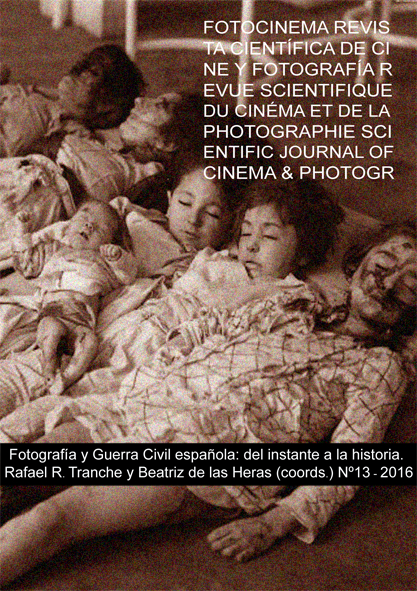La obra de Jaime Rosales. Diálogos con Robert Bresson
DOI:
https://doi.org/10.24310/Fotocinema.2016.v0i13.6066Abstract
El cine de Jaime Rosales se nos presenta como uno de los más diferentes dentro del panorama español (e incluso internacional), mostrando siempre una especial vocación por innovar, dando importancia a la investigación y la contemporaneidad en su trabajo. Toda esa factura se apoya en la obra y filosofía de cineastas pasados, maestros del arte cinematográfico como Robert Bresson. Este texto tratará de acercar las figuras de estos dos cineastas, confrontarlas, para, mediante el análisis, encontrar de qué manera ha podido influir el director francés en la obra de Rosales. Hallar respuestas que nos ayuden a vislumbrar los porqués que se nos plantean al acometer el estudio de la filmografía del director español.
Abstract:
Jaime Rosales’ filmography is presented to us as one of the most diverse in Spanish cinema, and also internationally. His work is distinguished by vocation for innovation, always giving special importance to research and modernity. All of this vision is based on the work and philosophy of other masters of cinema, such as Robert Bresson. The following text aims to compare these two filmmakers, examine them and find out by analysing, how the French director has influenced Rosales’ work. We will be looking for possible answers to the questions that this study raises about the Spanish director’s filmography.
Palabras clave:
Cine; Rosales; Bresson; diálogo; forma.
Keywords:
Cinema; Rosales; Bresson; Dialogue; Form.Downloads
Metrics
Publication Facts
Reviewer profiles N/A
Author statements
Indexed in
-
—
- Academic society
- N/A
- Publisher
- Universidad de Málaga
Downloads
Published
How to Cite
Issue
Section
License
All contents published in Fotocinema Revista científica de cine y fotografía are protected under the Creative Commons Attribution-NonCommercial-ShareAlike 4.0 International (CC BY-NC-SA 4.0) license. All about this license is available in the following link: <http://creativecommons.org/licenses/by-nc-sa/4.0>
Users can copy, use, redistribute, share and exhibit publicly as long as:
- The original source and authorship of the material are cited (Journal, Publisher and URL of the work).
- It is not used for comercial purposes.
- The existence of the license and its especifications are mentioned.
There are two sets of authors’ rights: moral and property rights. Moral rights are perpetual prerogatives, unrenounceable, not-transferable, unalienable, imprescriptible and inembargable. According to authors’ rights legislation, Fotocinema. Revista científica de cine y fotografía recognizes and respects authors moral rights, as well as the ownership of property rights, which will be transferred to University of Malaga in open access. The property rights are referred to the benefits that are gained by the use or the dissemination of works. Fotocinema. Revista científica de cine y fotografía is published in an open access form and it is exclusively licenced by any means for doing or authorising distribution, dissemination, reproduction, , adaptation, translation or arrangement of works.
Authors are responsable for obtaining the necessary permission to use copyrighted images.














13.png)



